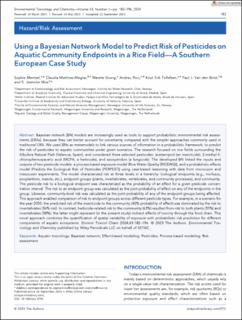Using a Bayesian Network Model to Predict Risk of Pesticides on Aquatic Community Endpoints in a Rice Field—A Southern European Case Study
Mentzel, Sophie; Martínez-Megías, Claudia; Grung, Merete; Rico, Andreu; Tollefsen, Knut-Erik; Van den Brink, Paul J.; Moe, S. Jannicke
Peer reviewed, Journal article
Published version
Permanent lenke
https://hdl.handle.net/11250/3113704Utgivelsesdato
2023Metadata
Vis full innførselSamlinger
- Publikasjoner fra Cristin - NIVA [2149]
- Scientific publications [1172]
Sammendrag
Bayesian network (BN) models are increasingly used as tools to support probabilistic environmental risk assessments (ERAs), because they can better account for uncertainty compared with the simpler approaches commonly used in traditional ERA. We used BNs as metamodels to link various sources of information in a probabilistic framework, to predict the risk of pesticides to aquatic communities under given scenarios. The research focused on rice fields surrounding the Albufera Natural Park (Valencia, Spain), and considered three selected pesticides: acetamiprid (an insecticide), 2-methyl-4-chlorophenoxyacetic acid (MCPA; a herbicide), and azoxystrobin (a fungicide). The developed BN linked the inputs and outputs of two pesticide models: a process-based exposure model (Rice Water Quality [RICEWQ]), and a probabilistic effects model (Predicts the Ecological Risk of Pesticides [PERPEST]) using case-based reasoning with data from microcosm and mesocosm experiments. The model characterized risk at three levels in a hierarchy: biological endpoints (e.g., molluscs, zooplankton, insects, etc.), endpoint groups (plants, invertebrates, vertebrates, and community processes), and community. The pesticide risk to a biological endpoint was characterized as the probability of an effect for a given pesticide concentration interval. The risk to an endpoint group was calculated as the joint probability of effect on any of the endpoints in the group. Likewise, community-level risk was calculated as the joint probability of any of the endpoint groups being affected. This approach enabled comparison of risk to endpoint groups across different pesticide types. For example, in a scenario for the year 2050, the predicted risk of the insecticide to the community (40% probability of effect) was dominated by the risk to invertebrates (36% risk). In contrast, herbicide-related risk to the community (63%) resulted from risk to both plants (35%) and invertebrates (38%); the latter might represent (in the present study) indirect effects of toxicity through the food chain. This novel approach combines the quantification of spatial variability of exposure with probabilistic risk prediction for different components of aquatic ecosystems.

